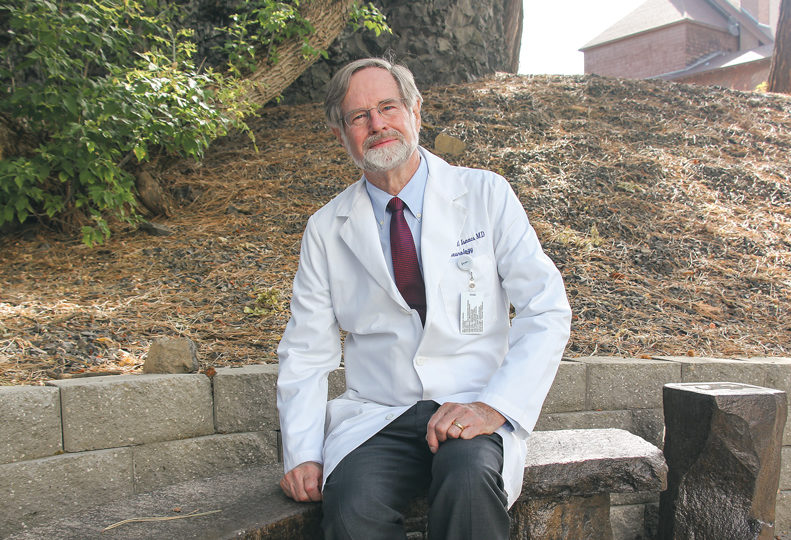
Home » St. Luke's launches physiatry residency program
St. Luke's launches physiatry residency program
Medical center offers three years of training in physical medicine, rehabilitation training

September 9, 2021
Providence St. Luke's Rehabilitation Medical Center has established its first cohort of a new physical medicine and rehabilitation residency program.
Dr. Kenneth Isaacs, regional medical director of health science at Providence, says six residents joined the three-year program in July.
Physical medicine and rehabilitation, also known as physiatry, is a field in which there are few opportunities for training in the Pacific Northwest, Isaacs says. The University of Washington operates a physical medicine and rehabilitation program in Seattle, but the next nearest program is at the University of Utah School of Medicine, in Salt Lake City, he says.
"Compared to the nation as a whole, training programs are thin on the ground in the West," Isaacs says.
Patients who need physical medicine and rehabilitation care often have trouble finding specialists, he says.
"In general, there's a shortage of rehabilitation specialists," he says.
Physical medicine and rehabilitation specialists, also known as physiatrists, treat a range of injuries and medical conditions that affect the joints, spinal cord, nerves, and muscles.
Issacs says St. Luke's is a prime location for a physical medicine and rehabilitation residency program.
"It's one of the largest freestanding rehabilitation centers in the western United States, if not the largest," Isaacs claims.
As of the Journal's Feb. 25 list of hospitals and medical centers, St. Luke's had a total staff of 382, including 15 doctors--12 of whom are physiatrists--and 84 registered nurses. With an operating budget of $50 million, the medical center has a total of 102 patient beds.
Because St. Luke's deals with a complex case mix in serving a variety of patients, Isaacs says the program is likely to appeal to many who are seeking a residency in the field.
"St. Luke's has a breadth of kind of patient and volumes of patients who need restorative rehabilitation care that really provides a basis of a world-class training program," Isaacs contends.
Hospitals throughout the region send their patients to St. Luke's for care, including the stroke center at Providence Sacred Heart Medical Center, Isaacs says.
"People who've had a stroke sometimes have residual speech and language difficulties, or difficulties with ambulation or difficulty using arms or hands," Isaacs says. "They can be admitted to St. Luke's for restorative care to work on those aspects. Residents then get to participate in learning more in-depth about those conditions and how restoration is approached."
St. Luke's is certified by the Commission on Accreditation of Rehabilitation Facilities in treating spinal cord injuries, brain injuries, strokes, and pediatric cases.
"It also has a neuromuscular program and a diagnostic program, as well as cardiac and pulmonary rehabilitation," Isaacs says. "Residents are able to participate in training in the broad spectrum of restorative care representing rehabilitation."
Residents will spend their first year of the residency working with attending physicians and therapists in St. Luke's inpatient treatment.
"In the second and third years, they'll expand to clinical work with our outpatient clinicians and our neuromuscular physicians in our neuromuscular clinic and lab, as well as in the amputation clinic," Isaacs says.
It takes about 12 years to become a fully qualified physiatrist, including obtaining a medical or osteopathic degree and completing an internship prior to starting a residency program, Isaacs says.
It's taken nearly that long to launch the physical medicine and rehabilitation residency program, Isaacs says. About 10 years ago, St. Luke's hired Dr. Greg Carter, who was then teaching at the University of Washington physiatry program.
"Dr. Carter had developed the initial vision of this program," Isaacs says. "He honed that vision over the years, particularly as Spokane increasingly became committed to medical education."
The development of the Washington State University Elson S. Floyd College of Medicine here, as well as establishment of the University of Washington School of Medicine - Gonzaga University Health Partnership, made the concept of a physiatry residency program more app-
ealing to Providence's administration, Isaacs says.
The concept of a residency program was supported by Dr. Judy Benson, who's the director of medical education for Providence, and who has overseen several Providence residency programs, Isaacs says.
With administrative support, Carter brought physiatrist Dr. Ross Bogey, who also has experience in developing residency programs, to St. Luke’s. Bogey led the final push to establish the program, Issacs says.
The physical medicine and rehabilitation program is the newest of several residency programs Providence Health & Services offers throughout the state, Isaacs says.
"Providence has several residencies, including in internal medicine, family practice, psychiatry, radiology, and others," he says.
Like this story?
You’ll love the rest. Subscribe today, and you’ll receive a year’s subscription to the Journal of Business, unlimited access to this website, daily business news emails, and weekly industry-specific
e-newsletters. Click here for 50% off your first year.
Latest News Special Report Health Care Education & Talent
Related Articles
Related Products



